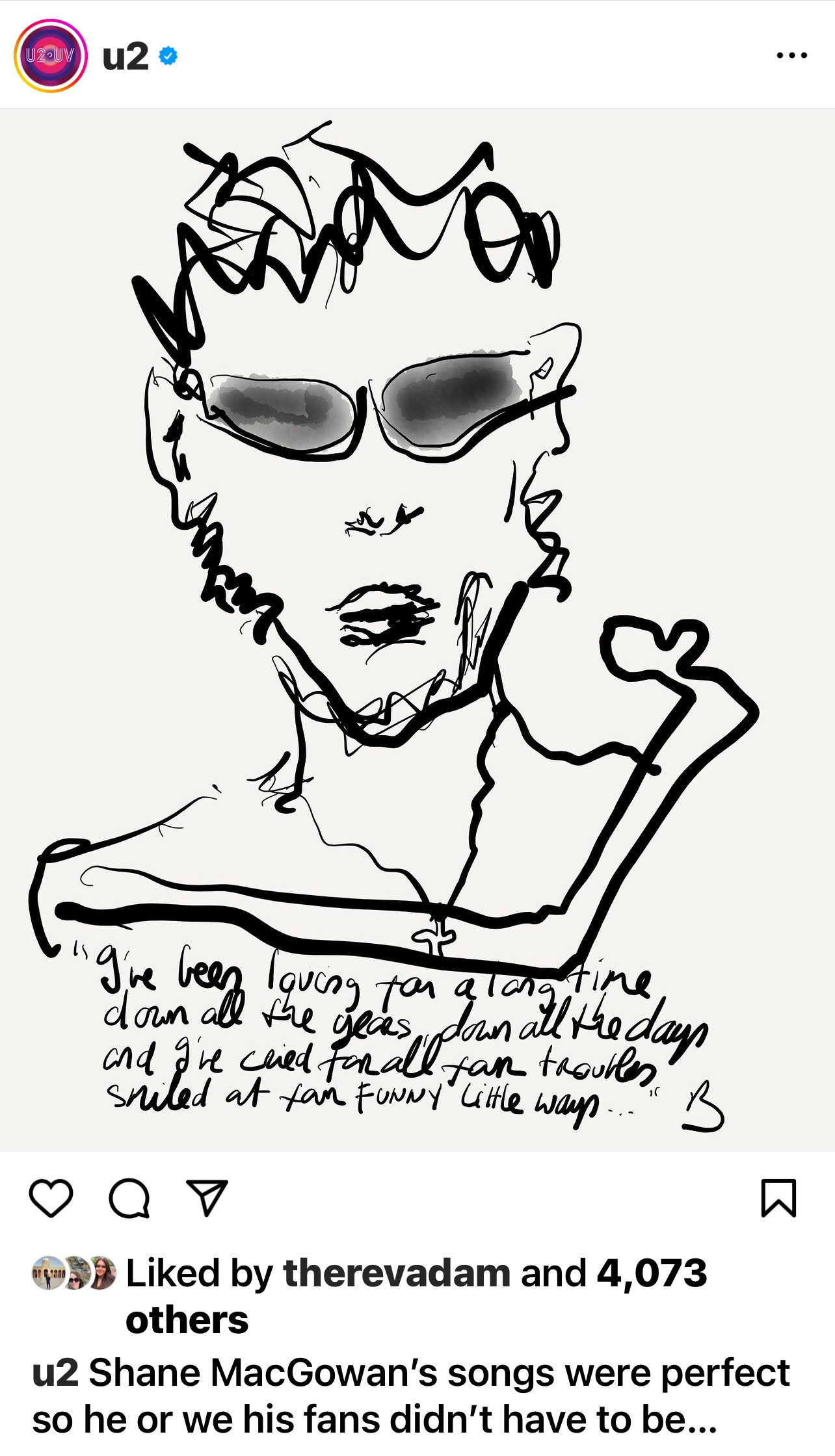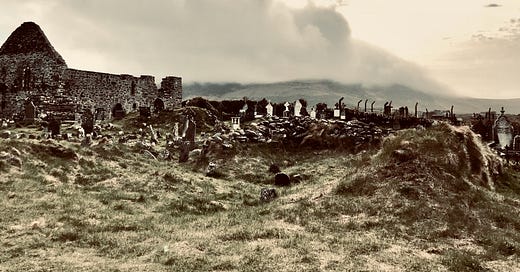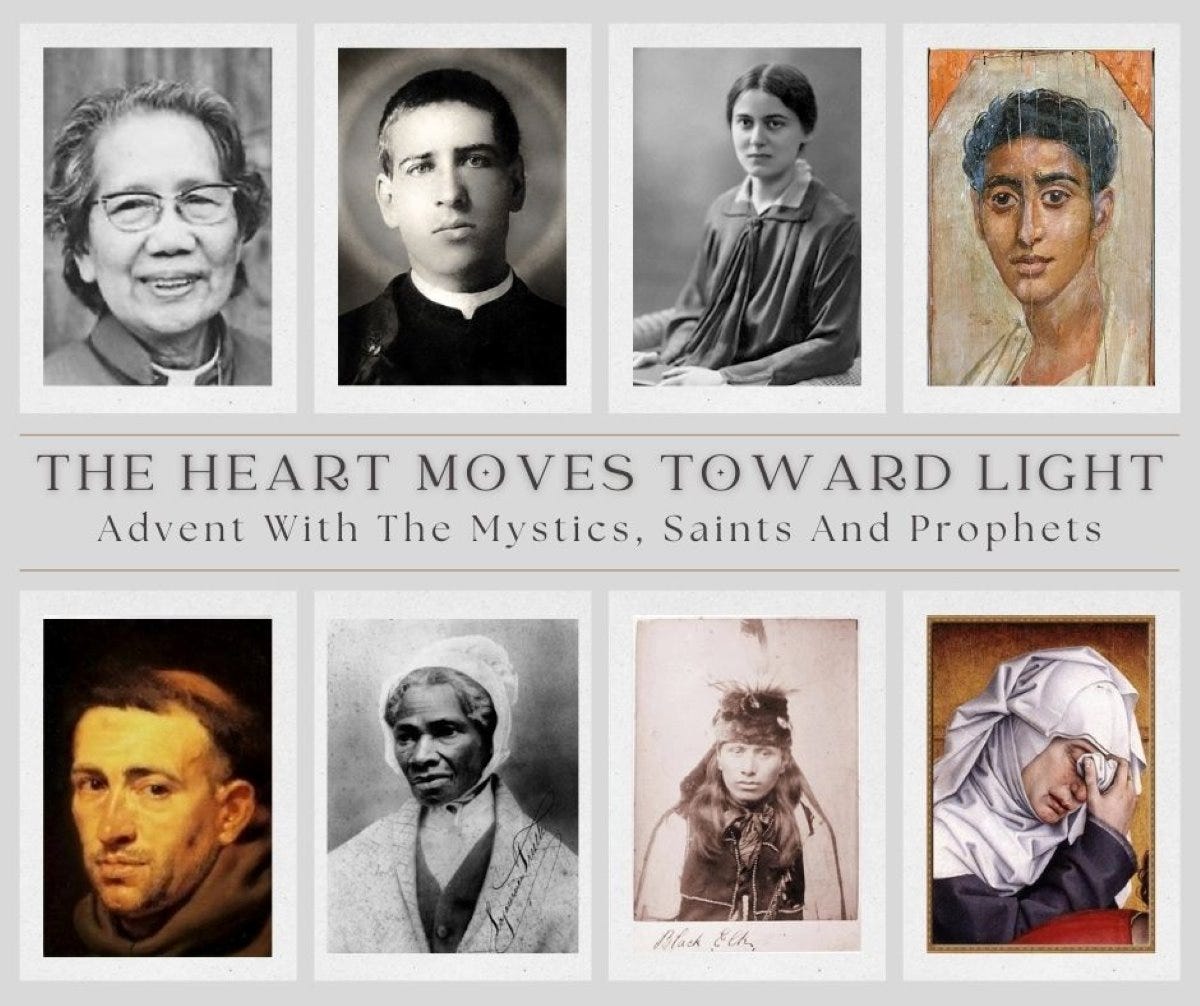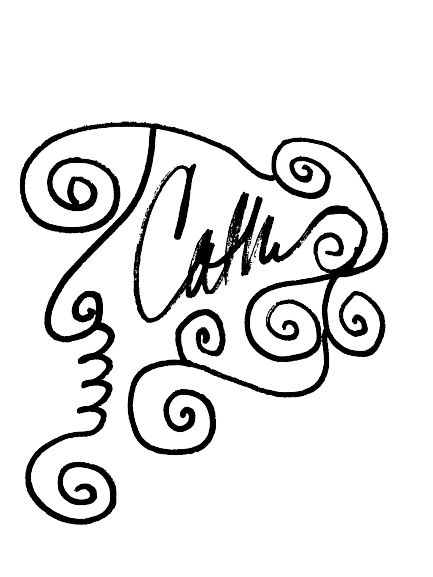KEENING: Songs to See Us Through
In this season of expectation some of us call Advent, many are navigating grief (individual, collective) for the absence of loved ones, for suffering, wars, despair. Here are sounds that might help.
Making sweeping generalizations about people groups is generally a bad idea, but sometimes such observations are accurate. For example:
The Irish are good at grieving.
I have found this to be true, personally and observationally, both in Ireland and among the Irish diaspora. This seemingly genetic predisposition to public and private mourning, the ability to embrace and express grief, has been on display for the world to see in the days since Shane MacGowan left this side of the veil for the More on December 1.
The night MacGowan — Ireland’s punk-poet laureate, the pride of Tipperary and punters everywhere, untamable, tender-hearted patron saint of London Irish, lead singer of The Pogues, and one of the most virtuoso lyricists of my generation — succumbed to pneumonia at age 65 after suffering from viral encephalitis for the last year and decades of generally hard living, Irish musicians including Glen Hansard, Pogues’ guitarist Terry Woods and Liam Ó Maonlaí of Hothouse Flowers appeared on RTE’s Late Late Show to pay tribute, in song and stories, to their friend.
There’s been so much death lately. Too much.
Last month, we lost my sister-in-law. The month before that, two friends.
These days, my socials seem to be filled with scores of friends, family, and acquaintanes who also are grieving the loss of a family member, friend, colleague, pet, sense of safety, peace of mind.
Two weeks ago, Rosalynn Carter went to her great reward at 96. The day after Shane died, former U.S. Supreme Court Justice Sandra Day O’Connor died at 93. A day before “Shane O’Hooligan” died, Henry Kissinger finally gave up the ghost at 100. (A friend remarked that we live in a world where a war criminal such as Kissinger lives for a century, when MacGowan, David Bowie, and Prince don’t make it to 70.) Le sigh.
As I was in the midst of writing this Monday, a friend texted to say her father had just passed. Less than 24 hours later, while I was trying to put the finishing touches on these ramblings, on Tuesday afternoon I heard that a former journalism colleague had died unexpectedly. She, too, was just 65.
In Gaza and Ukraine and Afghanistan and Ethiopia and Syria and Yemen and countless other locations around the world and around the corner, violence and terror and death prevail.
What do we do with all of that loss? With all this grief? How do we mourn? Where do we put the pain and absence and suffering and longing, how do we even begin to process it?
“The ritual of keening gives us permission to fall apart,” says Amanda Held Opelt (yes, the sister of our dearly departed friend Rachel Held Evans), author of the 2022 book A Hole In The World: Finding Hope in Rituals of Grief and Healing. “The Irish, you see, have an ancient tradition practiced after the death of a loved one known as keening. A keen, most simply put, is a funeral wail—a type of refrain that is more scream than song, more cry than chorus,” Opelt writes. “For the Irish, keening was a mystical and powerful art form, a holy act shrouded in mystery and a ritual emerging from a conglomeration of pagan and Christian beliefs.
“There was often a lead keener, in Gaelic called the bean chaointe. This role was almost always reserved for women. Many times, midwives served as the bean chaointe, women who knew well the thin divide between birth and life and death. They would usher people into the world, and they would usher them out,” she continues. “The act of keening served two purposes. One was to release the grief felt deep in the hearts of the mourners into the open air… to grieve with their whole bodies without feeling shame. The other purpose was to escort the dead into the other world, to the life after life. The keen would pay tribute to the lost loved one. … The keen would often begin with the bean chaointe singing or speaking in a low chanting voice, and then progress into a louder cry, with all the mourners joining in, some chanting, some moaning. The chorus of grief would sometimes take the shape of words about the loved one, but often language would collapse under the weight of the sorrow, erupting into wails and cries.”
Here are some sound samples of traditional keening from Ireland and Scotland. Feel free to skip to the next video as this is a very specific kind of sound experience and it’s not for everybody. The videos the follow might be more your speed, but this will give you as long or short a taste of traditional keening as you’d like:

The night after MacGowan’s death, at Sphere in Las Vegas, U2 paid tribute to their longtime friend with their take on “A Rainy Night In Soho” as Bono changed the lyrics to mark the occasion, singing:
'MacGowan's song is never over
Tho we may never found out what it means
There's a light I hold before me
You're the measure of my dreams,
The measure of my dreams'.
As discussed in earlier posts, for many of us music is both a means of catharsis and the fastest vehicle for getting us to a spiritual place that allows us to express ideas and emotions for which we ourselves cannot find the words.
Songs can crack us open and begin to heal us at the same time.
The videos that follow are of songs that I turned to this week and that have been helpful companions as I’ve navigated the strange terrain of grief in the past.
I hope they might be helpful to you, whether you’re actively grieving the death of a loved one; the loss of someone you didn’t know but who you admired, someone whose work or art or activism inspired or changed you; or if you, like countless others, are lamenting the general state of the world.
There’s a lot of Irish (and Irish-Americans) in here, but not exclusively.
Have a listen or a watch.
Please be gentle with yourself and others in these dark days of Advent, while we abide and look for the spark of incarnation and days that will begin again to grow longer and lighter.
Grab a box of tissues or a hanky — or two — for this one.
If Andrew Hozier-Byrne aka “Hozier,” the sweet-spirited, Wicklow born, Quaker-reared gentle man (in every sense of that word) doesn’t break your heart in this elegiac performance of “The Parting Glass” — the song I hope someone will sing, many decades from now, when my ashes are thrown into the roaring sea off of Malin Head — you might want to ask someone to check your pulse.
Liam Ó Maonlaí of Hothouse Flowers is an extraordinary musical artist. He also happens to be the first rock ‘n’ roll interview I ever did when I spoke to him and his bandmates after a show in Chicago in the summer of 1990 between my sophomore and junior years of college. The video below is part of a longer interview from my friend Jonny Clark’s excellent podcast, Guardians of the Flame. (Jonny is one of the folx I walked across Ireland with four years ago. He’s a peace activist and a filmmaker and head of educational programming for Corrymeela in Northern Ireland. If you’re unfamiliar with his work, you should look it up. Jonny is a bright light, beautiful soul, and great company.) The episode with Liam is particularly good. You can watch it in its s entirety HERE and I hope you do.
But first … here’s Liam, performing a few Irish language songs in the traditional sean-nós style. Even if you don’t understand the words, you’ll get the feelings they evoke.
When MacGowan turned 60, there was a star-studded ceilidh tribute to the irrepressible Pogues founder where seemingly everyone who was anyone in Irish music performed, including his anam cara and co-conspirator Sinéad O’Connor.
We lost Sinéad four months before Shane. None of us knows with certainty what happens after we die, and I’m not sure what I actually believe about it anymore (and I’m fine with that), but there’s part of me that hopes she was there to open the door for Shane when he got to the wherever/whatever happens next.
The Pogues’ song “Down All the Days” was written as a tribute to the Irish writer/artist Christy Brown, whose 1954 autobiography My Left Foot was made into a film starring Daniel Day Lewis. The song title is taken from Brown's first novel, Down all The Days, published in 1970.
The song was on The Pogues’ 1989 album Peace and Love (produced by Steve Lillywhite, husband of Kirsty MacColl, Shane’s partner in the now iconic “Fairytale of New York” song.) Think of ‘Down All the Days” as a slightly jollier lament/tribute to an extraordinary man, Brown, who died in 1981 when he was just 49 years old.
Christy Brown, a clown around town Now a man of renown, from Dingle to Down I can type with me toes, suck stout through me nose And where it's gonna end, God only knows Down all the days The tap-tap-tapping of the typewriter pays The gentle rattling of the drays Down all the days I have often had to depend upon The kindness of strangers But I've never been asked and I never replied If I supported Glasgow Rangers Down all the days The tap-tap-tapping of the typewriter pays The gentle rattling of the drays Down all the days Down all the days The tap-tap-tapping of the typewriter pays The gentle rattling of the drays I'm down all the days
This is U2’s little-known-outside-diehard-fan-circles very different song of the same name, began as a tune for Achtung Baby that eventually evolved into the song “Numb” on Zooropa. For me, it taps a familiar cathartic vein.
This song, “Keening,” from composer Donnacha Dennehy and performed by soprano Katherine Manley and the sean nós Iarla Ó Lionáird, captures myriad feelings of loss, lament, yearning, heartache, release, desolation, consolation …
There’s more than one way to keen, and as I was pulling this playlist of a kind together, a number of other singers whose voices and vocalizations in different genres of popular music contain the quality of the keen, if not the banshees themselves, came to mind:
Dolores O’Riordan, who we lost in 2018 before she reached her 50th birthday. Beloved Sinéad, now of blessed memory. And Dolores and Sinéad keening together. Our dear Patricia, aka Patti Smith, singing “Birdland,” a song inspired by a lost father. Eddie Vedder raging through his grief over a friend who died too young and senselessly. Jackson Browne. Karen Peris of the Innocence Mission in their “Song for Tom.” Springsteen honoring a lost comrade. The lamentations of Florence Welch (who venerates Ms. Smith in her song “Patrica”) in “Queen of Peace & Long and Lost.” Billie Strings’ youthful twang (with its roots somewhere in Celtic lands) singing the Grateful Dead’s elegy, “Brokedown Palace.” Lucinda Williams’ mourning a lost love. Kate Bush keening and hoping simultaneously in “This Woman’s Work.”
Because the Irish are also known for our dark humour when it comes to death and dying, and because I still miss Mr. Williams so much it physically aches, I thought I’d include this clip of him teaching Carol Burnett “how to keen” from her variety show back in the day.
You didn’t think I’d get through this post without a little poetry and one more Parting Glass did you? Of course you didn’t.
Here’s Seamus Heaney’s “Postcript” and a chorus of Irish musicians performing “The Parting Glass” a week after the great man left this world unexpectedly in August 2013.
Postscript by Seamus Heaney
And some time make the time to drive out west Into County Clare, along the Flaggy Shore, In September or October, when the wind And the light are working off each other So that the ocean on one side is wild With foam and glitter, and inland among stones The surface of a slate-grey lake is lit By the earthed lightning of a flock of swans, Their feathers roughed and ruffling, white on white, Their fully grown headstrong-looking heads Tucked or cresting or busy underwater. Useless to think you’ll park and capture it More thoroughly. You are neither here nor there, A hurry through which known and strange things pass As big soft buffetings come at the car sideways And catch the heart off guard and blow it open.
“In A Lifetime” is my favourite song of all time. It has moved me deeply since I first heard it when I was 17 years old. It moves me still every time I hear it as if I were hearing it again for the first time.
It wasn’t until recently, however, that I consciously connected the Clannad-Bono collaboration with death (even as there is a funeral procession in the video itself that appears to have gone over my head for 35 years.)
I cannot listen to it without weeping, even when I don’t know exactly why or for whom or what the tears come.
During U2’s stand of shows in Las Vegas this autumn, the Louis Armstrong version of “What A Wonderful World” often plays over the PA as the crowd disburses from Sphere at the end of the show. A friend shared this version with me yesterday. I think the lads might want to swap it out for the rest of their Vegas run.
Here are Shane and Nick Cave (who knows a thing or two about grief himself) in a minor-key duet-celebration of this world where beautiful and terrible things happen. And yet, as Fred Buechner and Seamus Heaney both remind us, “Don’t be afraid.”
#NoliTimere
Rest eternally in the grace from which you surely never fell, dear Shane.
Thank you for your words. For your faith, ferocity, transparency. For your gentle heart at the center of it all. And your wild, untamable, indomitable soul, which has found its way home.
My OG readers will know that I usually do some kind of daily Advent series here or on Instagram. This year, my Advent gift to myself is not to do that, and instead to rest, and to grieve, and to be still, and look for the light.
Please let me direct you, instead, to my dear soul brother, Greg Cash Durham, over at his Substack Life in the City, where he is running a gorgeous daily Advent reflection on saints — ancient, modern, official, unofficial. I invite you to spend part of your Advent contemplation with Greg and his saints, which you can find HERE.
The holidays are not so jolly for plenty of people. That’s why Blue Christmas services are a thing. It’s also why, I suspect, the musician and composer Kenneth Vigne began creating annual albums of piano improvisations of Christmas music set in minor or otherwise tragic keys three years ago. They’re something to behold. Part tongue-in-cheek, part seriously brooding, with titles such as “Blight Christmas,” “Chestnuts Roasting on a Lake of Fire,” and “In The Even Bleaker Midwinter.”
You can listen to this year’s album below and find his 2022 and 2021 offerings on his Soundcloud page HERE.
(HT Mother Christina O’Hara for the introduction to Vigne’s work.)
Special Holiday Sale: 50% Off Annual Subscriptions
Think of it as a BOGO. Buy one for yourself, give a gift subscription to someone you love — two for the price of one. Or four for the price of two. Or 20 for the price of 10.
Now through January 2, 2024.
Please be brave and kind. With others. With yourself.
And remember: You haven’t met yet everyone you will love, and you haven’t met yet everyone who will love you.
Much love from me,
ERRATUM: When I hit “send” on this post in email form, I hadn’t caught a mistake that said Shane MacGowan was the pride of “Limerick.” He was, in fact, the pride of Tipperary, of course, God love him. That’s where his people were from, where he spent many happy summers as a child, and where he will be laid to rest December 8.
My fiercest of apologies.









I love the word keening. You practice it just by saying it. This is beautiful Cath, thank you for offering this. Really helpful.
I learned so much here, as I always do when you write. But wow, the connection of music and morning and loss… That bears so much more examination. You have a book in you.
Thank you for the videos. I started with Robin Williams, of course, and it seems I will have an extensive playlist to get through slowly when I can. ❤️